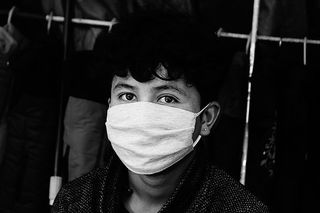Fear
Xenophobia in Response to Pandemics Is (Sadly) Normal
We might not like it, but fear of outsiders is an evolutionary protection.
Posted February 3, 2020 Reviewed by Ekua Hagan

Headlines and news cycles are filled with catastrophic proclamations and numbers regarding rising rates of coronavirus in China and growing numbers in the United States. These concerns are also leading to growing reports of xenophobia, and specifically, racism towards Chinese and Asian immigrants. Customers from mainland China have reportedly been banned from businesses in other parts of Asia, and in Washington State, a Costco worker allegedly told an Asian family with a child wearing a facemask to “move away” out of fear they might be from China and have the Wuhan coronavirus.
Racism is never appropriate or justified. It represents bigotry, fear, and discrimination, and is harmful to both society and individuals. Racial stereotyping is a dangerous form of discrimination, which typically emerges from a place of ignorance and broad generalizations, such as thinking: “They look Asian—the virus in the news is from Asia—they might have that virus.” In such thinking flows a very loose and subjective flow of logic, and is a form of logic which can easily lead to overreactions and gross generalizations.
However, appeals against racism may not be sufficient to overcome what is likely a deep-seated, evolutionarily influenced tendency in humans. The “parasite-stress theory” is a relatively recent body of research that explores the role that risks of infectious disease and viral and bacterial parasites have played on the psychology and sociology of humans.
This is a fascinating area of research, with extraordinary and far-reaching implications on understanding humans and how and why we act the way we do, both individually and collectively. This information is drawn largely from the work of Thornhill and Fincher, in their excellent and highly comprehensive work, The Parasite-Stress Theory of Values and Sociality.
Researchers have found that xenophobia itself, fear of others who are different from us, is heavily influenced by the local risk of parasitic infections. In one survey of world values, researchers found that people who lived in an area with a higher level of “combined parasite stress” (essentially, a measure of the risk of dangerous infectious disease) were much more likely to report they didn’t want to live next to someone of a different race, or someone who speaks a different language.
These researchers distinguish “ethnocentrism” from “xenophobia,” where ethnocentrism is a central focus on the needs of one’s own culture or race, as opposed to violent or fearful rejection of those who are different. Countries experiencing food shortages, for instance, are more likely to display higher levels of ethnocentrism, but not xenophobia, whereas higher levels of intergroup or tribal violence are likely to feed xenophobia and relatively less ethnocentrism.
Xenophobia, based on parasite stress and fear of infectious disease, rests on some basic biological principles: namely, that people who look more like me are more likely to have a similar immune system as I do. Their biology is expected to be somewhat similar to mine when it comes to their exposure to disease. And so, if they look generally healthy, they are likely not to be carrying something that would get me sick. But someone who looks different than me may have a very different immune system than I do, and thus they may expose my family or me to diseases which my body and immune system are unprepared for.
None of these are conscious thoughts but reflect a narrative that characterizes evolutionarily adaptive patterns of behavior. It’s worth noting that some evolutionary research involving the MHC (major histocompatibility complex, a genetic cluster influencing the development of the immune system) suggests that mating between people with dissimilar immune systems is actually likely to generate children who are more resistant to disease, and this factor may influence some mating selection tendencies, where people are more physically attracted to people who are different from them.
Higher levels of xenophobia, tribal conflict, and rejection of “out-group” members are found in parts of the world where there are higher levels of infectious disease and exposure to infection. And even in areas with lower levels of disease, xenophobia increases in the face of increased disease and infectious exposure. Areas of the world with higher levels of infectious disease have more authoritarian, “in-group” forms of government, and are more resistant to democratic form, and much more likely to adopt racist and xenophobic governing principles. As levels of parasite stress decreased in regions, for instance, through the introduction of antibiotics and increased access to medical care, peace follows.
Even at an individual level, researchers have found that people who live in areas with higher infectious disease are less likely to be extraverted, and much less likely to be open to new experiences, as both personality traits may be more likely to expose an individual to new, novel persons and diseases.
Thornhill and Fincher define xenophobia not merely as fear or hatred of people who are different than us, but say: “Xenophobia—the avoidance of and antagonism toward out-groups—is an adaptation or evolved solution to the problem of being maladapted to the infectious diseases parasitizing out-groups.” (p334) This suggests that rather than viewing xenophobia as an outpouring of intrinsic racism, selfishness, fear, and bigotry, it may help put things into perspective to understand that throughout human history, xenophobia actually was protective and adaptive.
This is not to say that xenophobia or racism at this time is justified or right. I’m not suggesting this in any manner. But shaming those who express xenophobic reactions is unlikely to be effective.
These xenophobic feelings don’t mean that these are people who have always secretly been racist. Instead, the parasite stress theory and research suggest that xenophobia was one way in which groups of humans tried to stay safe in a scary and dangerous world. Shaming people for normal feelings, fears, and thoughts is exactly how we drive these feelings underground into secrecy, where they fester.
University of California, Berkeley, put out a message about these issues, acknowledging that feelings of xenophobia were a common reaction to fear of disease. Unfortunately, the University received backlash for acknowledging this scientific fact and subsequently retracted the statement. Simply acknowledging that xenophobia has been adaptive in the past is not the same as endorsing or defending racism.
When people are afraid, as they are now, what they need are facts, not shame or to be called racist. Currently, rates of coronavirus in the U.S. are very low, far, far lower than rates of flu. Handwashing, good hygiene, and good infection-control procedures, such as containing coughing and sneezing, are effective ways to prevent and control infections. Fear, particularly ambiguous fear, results in increased levels of violence and rejection of out-groups and people who are different. We interrupt this pattern through more facts, including facts about the human history of xenophobia, both good and bad.




